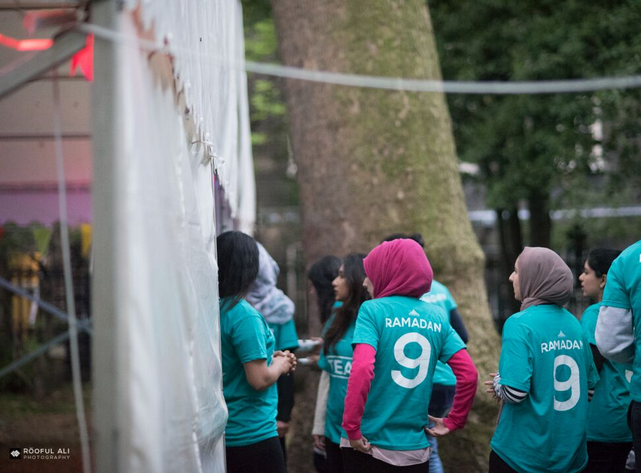
Tuba Mazhari
In the past few Ramadans, I have “oohed and aahed and gazed in admiration at the purple shirted volunteers of the Ramadan Tent Project (RTP). Like a proud mother I watched them serve food to others, all while having fasted themselves the entire day. I have thought to myself “they’re doing their bit. This alone is Dawah”. Knowing me, I may have even shed a tear. I wouldn’t put it past myself. Ugh. And that’s when I decided I wanted to join the purple haze of RTP volunteers – though we are now teal.
The Ramadan Tent project embodies virtues which are integral to Islam: hospitality, serving the community and showing one another kindness and respect. While the acts of RTP are Islamic and noble, it is unfortunate that this is not why I am praising the project. Rather, I am praising them for challenging misconceptions of Islam – something which has fallen upon the shoulders of Muslims all over the world.
What struck me most, however, was the way in which negative perceptions of Islam – fanatics, who are divisive and unwilling to integrate – were challenged. There was no bearded guy, standing outside a mosque, claiming to be hospitable. Nobody stood outside with a placard claiming to be peaceful or charitable. The founder and volunteers of the project came together and simply did. They simply showed. And that’s when the old cliché of actions speaking louder than words and the importance of coming together as one, felt truer and more relevant than ever.
Much like my teal pals, I wanted to challenge misconceptions of Islam. Now that I had decided I wanted to write about challenging misconceptions of Islam, I had to decide on which one. Let’s face it, there are plenty to choose from. Lucky Muslims.
I toyed with the idea of talking about the scary bearded man – a common image in the media. Non-Muslim friends have sheepishly told me that they would choose not to sit next to a man on the tube, if he looked too “Muslim”. She went on to say that she changed carriages or even got on to a different train, for fear that he may have packed something explosive in his bag. I considered revealing that not all bearded “Muslim-looking men” are scary. In fact, the only scary thing about most bearded men – such as my father – is how loudly they can snore. I thought it might also be informative to reveal that the idea of most bearded men being able to pack something explosive in to their rucksacks and getting on to a tube without their wives noticing, was unthinkable. Most bearded men I know, can barely prepare a lunchbox without being scolded by their wives for messing up the kitchen.
I toyed with the idea of discussing the stigma around “Allahuakbar”. I wondered whether I should describe that Allahuakbar means “God is Great”, and that it is used very frequently in prayer. Peaceful, regular prayer – carried out five times a day by Muslims all over the world. I also wondered whether I should say that it is probably more common for Allahuakbar to be screamed angrily by mothers who were distracted during Salat, than angry young men who are claiming to kill in the name of Islam.
Eventually, I decided to focus on women. Muslim women. I decided to cover (please laugh) the way in which Muslim women are portrayed in the media, and subsequently how this may affect the perception of Muslim women among non-Muslims.
Media coverage has been consistent in discussing Muslim women in one of three ways: The voiceless victim; What they wear or do not wear, and as a group rather than as individuals. I spoke with some non-Muslim friends about their perception of Muslim women: There were sentiments of pity expressed toward those whose entire faces were covered – via niqab; annoyance about not ever seeing women in positions of leadership and a general oppression of Muslim women, in other parts of the world.
To deny the oppression of Muslim women would be to belittle the plight of women who have suffered either in the name of Islam, or through cultural practices.
Having said that, the media coverage of the oppressed burqa-clad women is no less harmful. While such coverage may serve to highlight the plight of some women in Muslim countries, it does little to tackle oppression of women itself. The definition of oppression becomes “Muslim woman”. Other forms of oppression in the western world: the gender-gap in pay, the impossible beauty standards set for women become less salient, and less likely to be tackled. The portrayal of Muslim women as silent and submissive, combined with little coverage of women in positions of power, silences their voice where it should be loudest: In calling out injustice against women, and reconceptualising the notion that they are oppressed by their religion.
I wondered about how to challenge the notion of the burqa-clad, man-obeying, helpless woman. I am not saying she doesn’t exist. I am simply saying that her religion has not deemed it for her to be this way.
Like my teal-shirted pals at RTP, I wanted to portray Islam in in its truest and most authentic sense. The obvious thing to do then is to discuss the first woman to have accepted Islam, Khadija (RA). She is considered to be the mother of believers – and therefore an example by which all Muslim women should abide.
Khadija was married to Prophet Muhammad (SAW). Prior to her marriage to the Prophet (SAW), Khadija had married twice before. She had received several proposals for remarriage, but had declined the offer.
She was a well-established business woman and was employing several men – including the prophet (SAW) – to transport her goods, and to trade on her behalf. Khadijah had reached levels of success several women – and men – aspire to attain today. She was independent, and able to take care of herself. Khadijah was also independent in the way she thought – she did not sympathise with the worship of Idols, even before Islam. She did not mock or abuse those who claimed that a messenger of god was due to arrive, even when others did.
After learning of the prophet’s qualities, she chose to marry him. She proposed to him herself. The first woman of Islam was brave, and courageous.
Khadjija (RA) was a major source of support to the prophet (SAW) in his mission to spread Islam. She was the first person to learn about his experience in the Cave of Hira; the first to affirm his prophethood. She stood by him when he was mocked, and reminded him that he was supported by God and would not be disgraced in his efforts. She was an ally; a motivator; a supporter.
The focus on Khadija’s (RA) attributes and all that she achieved, rather than how she looked, in Islamic history is refreshing and inspiring. It is a reminder to Muslim women, and women world-wide, that their ability to stand up in the face of adversity and to show wisdom at all times are what matters. Not the size of their waist, or the colour of their tan.
If there is a perception to be reconceptualised, it is that there is such a thing as a typical Muslim woman. Muslim women come in various shapes, colours and sizes. There is no typical Muslim woman. There is however an ideal Muslim woman: The mother of believers, who was courageous, brave, supportive and smart. While, as Muslim women, we may be dissimilar in many ways, I take pride in being united by our desire to emulate the attributes of Khadija (RA).
Sources
http://muslima.globalfundforwomen.org/content/muslimwomeninthemedia
Mujahid, A.M. 2012 Golden Stories of Sayyida Khadija DarUsSalam. Riyadh

